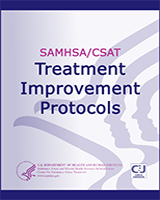Brief Interventions and Brief Therapies for Substance Abuse
Treatment Improvement Protocol (TIP) Series, No. 34
Authors
Center for Substance Abuse Treatment.This TIP, Brief Interventions and Brief Therapies for Substance Abuse, is intended primarily for counselors and therapists working in the substance abuse treatment field, but parts of it will be of value to other audiences, including health care workers, social services providers, clergy, teachers, and criminal justice personnel. In fact, those portions of this TIP dealing with brief interventions will be of use to any professional service provider who may need to make an intervention to help persons with substance abuse disorders alter their use patterns or seek treatment. However, brief therapy should only be practiced by those who are properly qualified, educated, and licensed.
The first chapter of this TIP presents an overview of brief interventions and brief therapies, describing their basic characteristics and the reasons for increased interest in them. Chapter 2 describes the goals and components of brief interventions, and Chapter 3 discusses some of the basic elements of all brief therapies. Chapters 4 through 9 each highlight a different type of brief therapy, describing the theory behind it as well as some of the techniques developed from that theory that can be used to treat clients with substance abuse disorders. Separate chapters are presented describing cognitive-behavioral therapy, strategic/interactional therapies, humanistic and existential therapies, psychodynamic therapies, family therapy, and group therapy. Appendixes are also included that provide resources for further information and training, a glossary of terms used in the TIP, and a sample workbook for use in brief interventions.
The goal of this TIP is to make readers aware of the research, results, and promise of brief interventions and brief therapies in the hope that they will be used more widely in clinical practice and treatment programs across the United States.
This publication is part of the Substance Abuse Prevention and Treatment Block Grant technical assistance program. This publication was written under contract number 270-95-0013 with The CDM Group, Inc. (CDM). Sandra Clunies, MS, ICADC, served as the CSAT government project officer. Rose M Urban, LCSW, JD, CCAS, served as the CDM TIPs project director. Other CDM TIPs personnel included Raquel Ingraham, MS, project manager; Jonathan Max Gilbert, MA, managing editor; Janet G Humphrey, MA, editor/writer; Cara Smith, production editor; Erica Flick, editorial assistant; Y-Lang Nguyen, former production editor; and Paul Seaman, former editorial assistant. Special thanks go to consulting writers Scott M Buchanan, MSEd; Dennis M Donovan, PhD; Jeffrey M Georgi, MDiv; Delinda E Mercer, PhD; Larry Schor, PhD; and George E Woody, MD.
The opinions expressed herein are the views of the Consensus Panel members and do not reflect the official position of CSAT, SAMHSA, or the U.S. Department of Health and Human Services (DHHS). No official support or endorsement of CSAT, SAMHSA, or DHHS for these opinions or for particular instruments or software that may be described in this document is intended or should be inferred. The guidelines proffered in this document should not be considered as substitutes for individualized client care and treatment decisions.
